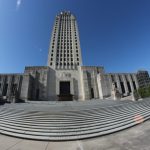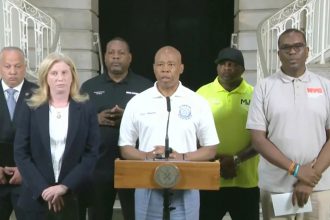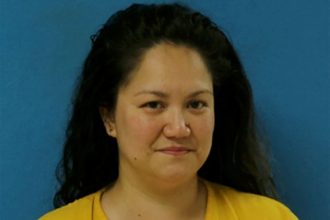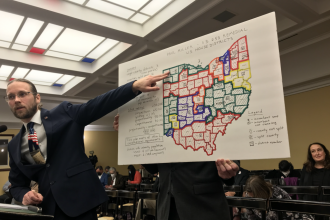From left, Rotarian Barry Sackett moderates a panel on food insecurity with Feeding South Dakota Executive Director Lori Dykstra, Church on the Street Deacon Mara Stillson and Avera Health dietitian Stasia Elsinger on Oct. 27, 2025, in Sioux Falls, South Dakota. (Photo by Makenzie Huber/South Dakota Searchlight)
Nearly 75,000 South Dakotans — roughly one in 12 residents — will lose food assistance benefits if the federal government shutdown persists into next week, state officials acknowledged Monday.
The state has no plan to cover benefits from the Supplemental Nutrition Assistance Program if Congress doesn’t act before the program’s funding runs out. The program provides qualifying low-income people — who must meet work requirements, unless they qualify for an exemption — with a preloaded card they can use to help cover grocery purchases.
“If the federal government’s shutdown continues and SNAP benefits are not funded in November, recipients will not receive SNAP benefits for that month,” said the state Department of Social Services. “The federal government has communicated that states would not be reimbursed if they choose to fund benefits to SNAP recipients.”
The federal program provided $14.76 million worth of assistance to 74,459 South Dakotans in September — including 33,198 children.
Another safety net program supplying food and formula to women, infants and children, known as WIC, is also set to run out of federal funding next week if the shutdown continues. WIC serves about 13,800 South Dakotans monthly.
The South Dakota Department of Health did not answer a question from South Dakota Searchlight asking if the department plans to use state funding to keep the program running.
“At this time, WIC benefits remain available, and the program operations are continuing as normal,” a department spokesperson said in an emailed statement.
Impossible for nonprofits to fill federal funding gap
Food insecurity professionals told members of the Downtown Sioux Falls Rotary Club during a panel discussion on Monday that food shouldn’t be used as a political bargaining chip.
One in five South Dakota children are food insecure, Feeding South Dakota Executive Director Lori Dykstra said. More than 70% of participants in South Dakota’s SNAP program have children in their families.
Feeding South Dakota Executive Director Lori Dykstra speaks to Downtown Sioux Falls Rotary Club members on Oct. 27, 2025. (Photo by Makenzie Huber/South Dakota Searchlight)
Dykstra said she understands South Dakota’s decision not to fund November SNAP benefits “from a budgeting standpoint,” but she added that “a lot of states are making those decisions; some states are choosing to fund it.”
New York, for example, will supply $30 million in state emergency food assistance. On Friday, 23 state attorneys general sent a letter to Agriculture Secretary Brooke Rollins and questioned the legal basis for the agency to pause benefits for SNAP.
The state Department of Social Services said it is “closely monitoring federal developments” with the program and working to connect people with local resources, including through the Helpline Center. The department’s website says remaining balances from October and earlier will stay available for use.
Panelists encouraged South Dakotans to volunteer their time or donate to food pantries across the state.
Dykstra added that Feeding South Dakota is working to create an emergency response plan to address a spike in food insecurity if the shutdown continues. The hunger relief nonprofit already lost 1.5 million pounds of food to federal cuts in March.
“We need to be prepared,” Dykstra said. “But we also can’t meet the entire gap.”
For every one meal Feeding South Dakota provides, SNAP provides nine. “We cannot make that up in a matter of a couple of weeks,” Dykstra added.
Disruption could stress hospital systems, child safety
Stasia Elsinger, a dietitian with Avera Health, told South Dakota Searchlight after the panel discussion that she expects hospitalizations to rise across South Dakota if SNAP benefits end — especially in areas of the state with high rates of diabetes and other chronic illnesses. Native Americans are 1.8 times more likely to be diagnosed with diabetes than other South Dakotans, according to the state Department of Health.

Stasia Elsinger, a dietitian with Avera Health, speaks to Downtown Sioux Falls Rotary Club members on Oct. 27, 2025. (Photo by Makenzie Huber/South Dakota Searchlight)
“We are all one medical diagnosis, one car accident, one family emergency away from also being food insecure,” Elsinger told Rotary members. “We have patients who went from doing great to needing to utilize programs like these just to survive. We see it every day, and we’re seeing it more and more now.”
The Standing Rock Sioux Tribe declared a state of emergency due to the government shutdown over the weekend, citing the temporary impact to SNAP and WIC programs.
Department of Social Services Secretary Matt Althoff said in a Board of Social Services meeting earlier this month that the department is “crossing our fingers that reason prevails in Washington” to continue the SNAP program.
Board member Stacey Tieszen said at the meeting that the fallout from the disrupted program will happen right away and could cost the state more in the long run. Tieszen serves as CEO of the Sioux Falls Area Court Appointed Special Advocate nonprofit.
“Families that are stressed are not good parents. Those parents might end up making poor choices,” Tieszen said at the time. “That might lead to substance abuse issues; they might hurt their children. Then that all impacts DSS because then there are removals and foster care.”
SNAP loss could hurt grocery stores
Dykstra told South Dakota Searchlight after the panel that the loss of SNAP benefits would impact the state economically, and is especially important for rural grocery stores.
“I don’t want to see more closures,” Dykstra said.
RF Buche, president and CEO of GF Buche Co. in South Dakota, told South Dakota Searchlight that his stores stay open past midnight on days that benefits are loaded on SNAP cards — the 10th of each month.
All 25 stores owned by Buche, which include Buche Foods and Gus Stops, are on or near tribal land. A majority of Buche’s customers use SNAP, he added.
Parents carry or push their sleeping children in carts as they stock up for the month, Buche said, adding that some customers likely “haven’t eaten in days.” He added that if the SNAP funding is disrupted, it’ll be “devastating” for communities he serves.
“I don’t know how anybody in good conscience could sit there and not worry about those struggles,” Buche said.
Team Buche Cares had been planning to donate 50,000 Thanksgiving meals this year, but Buche said he now plans to give $100 worth of groceries per SNAP household if the shutdown continues past Nov. 10. If the shutdown ends before then, he plans to use that money for Thanksgiving.
“Unfortunately, we may not have the choice to get to Thanksgiving,” Buche said. “I don’t think starvation will wait around until Team Buche Cares provides Thanksgiving meals. It’s going to begin November 10th.”
SUBSCRIBE: GET THE MORNING HEADLINES DELIVERED TO YOUR INBOX









